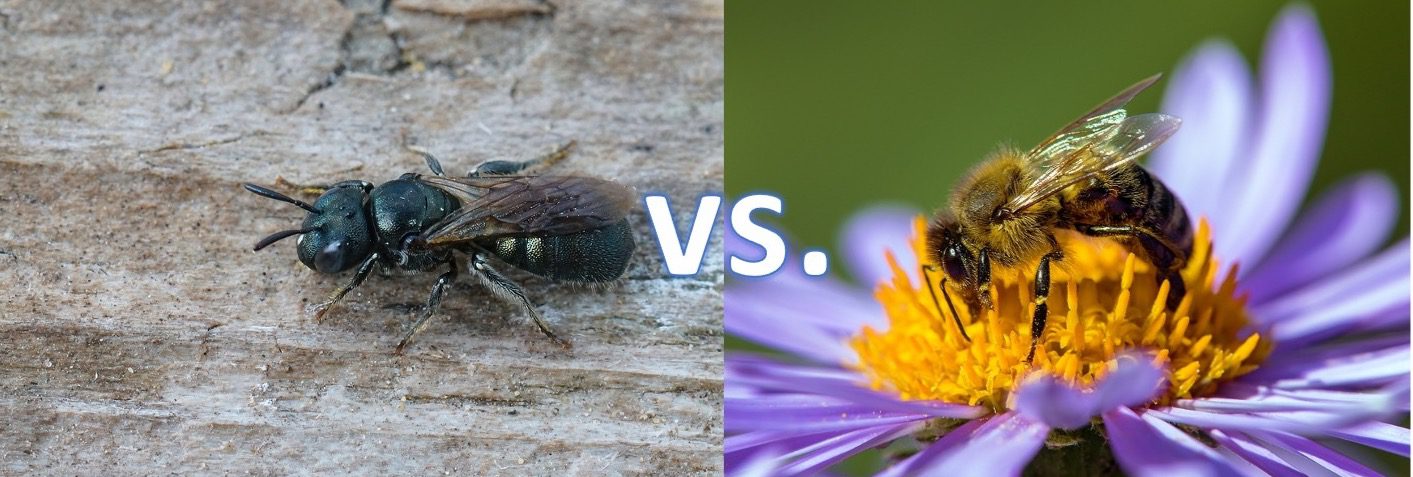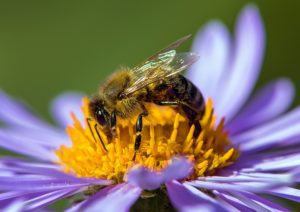
Carpenter Bees vs. Honey Bees
Carpenter bees are solitary insects that live in wood and create tunnels to lay their eggs, while honey bees are social insects that live in hives, produce honey, and are responsible for pollinating a large portion of our food supply. Learn more about these two very different species of bee and their unique characteristics, behaviors, and habits.
BEE REMOVAL QUOTESWhat Is the Difference Between Carpenter and Honey Bees
Carpenter bees are large, black, and yellow insects. Unlike honey bees, they don’t live in hives or produce honey. Instead, carpenter bees will bore into wood to create tunnels for their nests. They often make these tunnels in wooden structures such as decks, porches, and window sills; hence their name, carpenter bees. Male carpenter bees are highly aggressive and will defend the nest by buzzing around the intruder.

Honey bees, on the other hand, live in large colonies of up to 80,000 individuals. They produce honey which they use as a food source and store in their hives for future use. Honeybees also pollinate a large portion of the food we eat, and are essential to our agricultural systems. Honey bees are not aggressive and rarely sting unless provoked or disturbed. Don’t like bees? Find a bee removal service near you.
4 Carpenter Bee Facts
1. Carpenter bees are large, robust bees that can range in size from ¼ inch to 1 inch long.
2. They get their name because they bore into wood and create tunnels to lay their eggs, which is why they are sometimes mistakenly called “wood-boring” bees.
3. Females have a “stinger” which is actually an ovipositor used to lay eggs, but they rarely sting and usually only do so if provoked.
4. Carpenter bees are excellent pollinators of flowers and crops and feed primarily on nectar and pollen from plants.
4 Honey Bee Facts
1. Honey bees are small, fuzzy insects that range in size from ¼ inch to 5/8 inch long.
2. They are social insects that live in hives, which can contain up to 50,000 individuals.
3. Honey bees produce honey from the nectar of flowers and use it both for food and to help regulate their hive temperature during winter months.
4. Honey bees are essential pollinators of flowers and crops, helping to produce much of the food we eat. They can also be trained to pollinate specific plants or crops.
Both carpenter bees and honey bees play an important role in our environment by providing vital pollination services. However, their differences in behavior, size, diet, and living arrangements make them two distinct species. It’s important to recognize and respect their differences in order to protect both of these beneficial insects.
What Do Carpenter and Honey Bees Eat?
Carpenter bees feed on pollen and nectar from flowers like most other bee species. They also visit trees for their sap which they use to produce a secretion that they mix with pollen, nectar, and saliva. This mixture forms their food source and is fed to their young.
Honey bees primarily feed on nectar and pollen from flowers. They also collect sap, honeydew, and other sugary substances as additional sources of food. Honey bees are the only bee species that produce honey, which is a mixture of nectar and bee saliva. They store this food in their hives for later use.
What Are the Behaviors and Habits of Carpenter and Honey Bees?
Carpenter bees are solitary insects that do not form colonies as honey bees do. They establish burrows inside the wood to lay their eggs and will reuse the same burrows for multiple generations. Carpenter bees are also known to be relatively territorial and defensive of their nests.

Honey bees, in contrast, form large colonies with a complex social structure. They build wax and honeycomb structures inside tree cavities or other sheltered places that they use as their nests. Unlike carpenter bees, honey bees do not actively defend their nests and instead rely on the collective force of their colony to protect themselves from predators.
Honeybees have several distinct behaviors that help to keep the hive functioning. Worker honey bees are responsible for collecting nectar and pollen, caring for young broods, building wax combs, regulating the temperature of the hive, and defending against predators. In addition, honey bees have a very sophisticated system of communication between members of the colony that helps them to locate food sources and alert the other members about potential threats.

Carpenter bees, on the other hand, do not have this level of social organization. They are solitary creatures whose goal is to find appropriate nesting sites, build their burrows, and lay their eggs. They do not show cooperative behaviors with other individuals of the same species.
In conclusion, carpenter bees and honey bees have significant differences in terms of their behaviors and habits. While both are important pollinators and beneficial to ecosystems, honey bees display more complex social behaviors and rely on collective defense strategies, whereas carpenter bees are solitary and territorial creatures. Understanding the differences between these two species can help us better understand how to protect and promote their populations.
BEE REMOVAL QUOTES
Leave a Reply